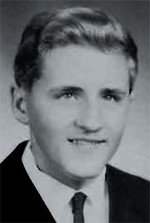Clipper Chatter
| Forum: Member Stories | |||||
|
|||||
|
Christopher Newman
 Posts: 28 View Profile |
Haussner's Restaurant, Eastern Avenue Posted Sunday, April 10, 2011 10:33 AM
Haussner's Restaurant Eastern Avenue at Clinton Street, Highlandtown, Baltimore, Maryland In Baltimore, in the late 19th and 20th century, many of the most popular restaurants were owned by Germans and served typical German fare, like sauerbraten, calf's head and hasenpfeffer, much of it marinated in vinegar and water, onion, spices and sugar before being cooked. There was a preponderance of German emigrants in the city at the time. In many of the public and parochial schools German was taught as a second language, and sometimes spoken exclusively. William Henry Haussner was a leading chef at the Museum School in Nuremburg before coming to Baltimore. He opened his Highlandtown restaurant in 1926 and along with his wife, Frances Wilke Haussner, and their children, Haussner's restaurant remained open for 73 years. Although Haussner's began as a German restaurant and bakery, famous for its sauerbraten, roast beef, Hungarian goulash, "Wiener Schnitzel A La Holstein", red cabbage, fried eggplant, stewed tomatoes, fresh baked German rolls and bread, honeycake and its famous "strawberry pie", it later added crabcakes, imperial crab, shrimp and flounder stuffed with crabment, lobster, oysters and rockfish from the Chesapeake Bay. Haussner's Restaurant was one of Baltimore's most celebrated restaurants. It housed an extraordinary collection of European and American paintings, sculpture, and various antiques and artifacts. The ambience of several large dining rooms, filled with art, beautiful lighting effects, white linen tablecloths and oversize linen napkins to match was just the beginning of a delightful dining experience. The waitresses, many from East Baltimore, dressed in perfect white uniforms, wearing beige stockings and white shoes, were always friendly and welcoming. If customers seemed overwhelmed with the menu, the waitresses would gladly advise them about what to order. Baltimore was renowned for its "Southern Hospitality" and fine food. At Haussner's, the native Baltimorean, the tourist, the art lover, would enjoy both - with an extensive menu, at moderate prices. Haussner's clientele was an eclectic mix of people. The debutante from Guilford or Dulaney Valley might very well be sitting next to the Gunther Brewery truck driver from Highlandtown. The Gibson martini drinkers from Roland Park, wearing their tweeds and tartans, could be sitting across from a steelworker's family from Dundalk. Cocktails, during the 1960's, cost about $1.00, Mint Juleps, in season, the most expensive drink at Haussner's, cost $2.50, bottled beer, .50 cents to $1.00. (For less than $10.00 you could go "up the creek with Jim Beam!" - and then have a huge roast beef sandwich or a "Baltimore" crab cake). The old fashioned stag bar, filled with tobacco smoke and portraits of reclining naked goddesses, remained "for gentlemen only" well into the 1960's. The fame of Haussner's even showed up (recently) in episode 27 of the popular television series, "Mad Men" - where Donald Draper and Sal are shown having dinner with a couple of stewardesses in Haussner's. As the story line began, they flew into Baltimore from "Madison Avenue" to promote an advertising campaign for the London Fog Company. The beautiful room, depicted, looked just like Haussner's in the early 60's, with one exception, the table linen in the show was yellow instead of white. Among my fond memories of Haussner's is Mrs. Frances Wilke Haussner, whom John R. Dorsey (former Sunpaper art critic and restaurant reviewer) said was "the soul of Haussner's." Former governor and Baltimore mayor, William Donald Schaefer, said that "Mrs. Haussner was a great and very stately lady." She retired in the 1970's relinquishing the management of the restaurant to her daughter Mrs. Frances Haussner George, and her husband Steve. I remember her so well; she was elegant and gracious very much like her mother, and always available to assist customers or staff. Mrs. George, probably in her sixties then, was tall, slender, well dressed, and wore her hair up and pinned back. I usually saw her there on a Friday or Saturday night, acting as hostess. According to one waitress, Frances Kutzberger (who worked at Haussner's for 11 years), "Fran George was a hands on owner! It was nothing for her to scrub a pot if it needed to get done!" She also said "from owners to the staff...we were family, I am proud to say that I worked there!" Mrs. Frances Wilke Haussner died at the age of 91 on October 2, 2000 ... just one year after Haussner's closed its doors on October 7, 1999. Much of the art collection was auctioned at Sotheby's on November 2, 1999. One of my favorite paintings, "I'se Biggest!" by Arthur John Elsley in 1892, shows a pretty little girl, standing on a book, leaning against a very large Saint Bernard dog. The painting was reproduced on a postcard as were other paintings. Thousands of postcards must have been printed - and compliments of Haussner's they were free to their customers. "I'se Biggest!" was also reproduced on the front cover of the Haussner menu in later years. The original painting sold for $673,500. to a private American collector. I am happy to share these memories (and history) with my classmates. I am also grateful that I lived at a time when Baltimore City, Highlandtown, Haussner's Restaurant and Patterson (Park) High School were at their very best. Christopher Newman April 10, 2011 P.S. You might like to read, "The Amiable Baltimoreans", written by Francis Beirne, first published in 1951. It presents 250 years of anecdotal history about Baltimore City - its architecture, its institutions, its customs and traditions, and most of all, its people. |
||||
|
|||||

